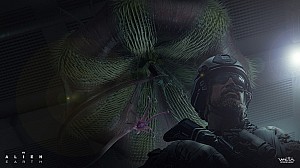This post was published by a guest. The views expressed are those of the author and do not necessarily reflect the views of alien-covenant.com.
The intersection of extraterrestrial themes and video game design has long been a source of innovation within the industry. The concept of alien life fuels the imagination and pushes the boundaries of game development far beyond earthly confines.
Let's learn how the unknown has enabled game developers to experiment with new narratives, gameplay mechanics, and visual aesthetics, profoundly embedding them into video game evolution. The legacy of these outer space narratives extends beyond mere entertainment, influencing how games are made, experienced, and perceived by audiences worldwide.
The Atmospheric Blueprint
The concept of extraterrestrial encounters has profoundly influenced the atmospheric storytelling techniques used in video games. It encourages a shift toward more immersive and emotionally engaging environments. This transformation is evident in the meticulous crafting of game worlds. These worlds capture the essence of isolation, claustrophobia, and the unknown. They are hallmark traits inspired by narratives centred around alien life and their mysterious realms.
This penchant for immersion and thematic richness extends beyond action-adventure or sci-fi genres. Once exclusive to video games, the arcade feels integrated into casino games. Soon, you can enjoy these themes in Betway's blackjack, poker, and roulette, among other games. The alien ambience will add an extra layer of excitement to the traditional casino experience.
In video games, advanced environmental design allows developers to create settings that are critical components of the storytelling process. These environments are often characterized by their ability to evoke a sense of unease and solitude.
They play a pivotal role in immersing players into the game's narrative. The dimly lit corridors, vast open spaces with minimal signs of life, and the haunting echo of distant sounds contribute to a palpable tension, enhancing the gaming experience.
Furthermore, the strategic application of audio-visual elements serves to amplify the atmospheric impact. Sound design, in particular, has been utilized to great effect. Ambient noises, soundtrack cues, and silence build suspense and convey the presence of unseen threats. Visuals have evolved, too.
The use of lighting, texture, and color schemes work together. They evoke specific emotional responses from players, making them feel truly embedded within these alien landscapes. For instance, sites such as www.jalwagamee.win explore similar innovations in game design, offering insights into how these themes enhance the overall gaming experience.
Environment and World Building
The influence of the alien theme on the environment and world-building in video games cannot be overstated. This theme pushes developers to create rich, immersive worlds that blend the familiar with the utterly alien. Games such as Destiny, StarCraft, and No Man's Sky showcase how alien settings can enhance the depth and immersion of game environments.
- Alien Ecosystems - One critical aspect is the design of the flora and fauna that would inhabit these alien worlds. These elements add layers of realism and challenge players to adapt to new threats and puzzles.
- Architecture and Ruins - Another critical aspect is the design of the flora and fauna that would inhabit these alien worlds into game worlds, providing a backstory without direct narration. The influence of the alien's theme on the environment and world-building in video games cannot be overstated.
- Interstellar Exploration - Games that include space travel and the discovery of alien planets emphasize the universe's vastness and variety of life. They encourage players to explore and interact with diverse environments.
- Cultural World-Building - Beyond physical environments, some games develop unique alien cultures. These can include languages, social structures, and technologies that players can learn about and engage with
Weaponry and Realism in Sci-Fi Arsenal
The theme of aliens has significantly influenced the realism and design of weaponry across various video games. This theme has led to an exciting blend of fantastical weapon concepts grounded in practicality.
Video games such as "Doom," "Half-Life," and "Halo" stand out for their innovative approach to weaponry within an alien context. These games strike a balance, integrating alien technology and concepts while maintaining a sense of realism.
In Doom, players use advanced weapons that, despite their futuristic capabilities, feel plausible and effective against extraterrestrial threats. Half-Life mixes conventional firearms with alien technology, creating a diverse arsenal that encourages strategic thinking and adaptability.
Meanwhile, Halo further explores this concept by offering various human and alien weapons. Each weapon is designed to be unique yet intuitive, allowing players to engage in strategic combat that feels both extraordinary and realistic.
This nuanced approach to weapon design deepens the gaming experience. It connects players more intimately with the game's universe by making the implausible seem achievable. Additionally, it challenges players to utilize their arsenal thoughtfully, adding a strategic layer to the immersive and engaging gameplay.
Takeaway
The alien theme remains a powerful catalyst for innovation and creativity in video game design. It challenges developers to push the boundaries of storytelling, gameplay mechanics, and world-building. By blending the familiar with the unknown, games that explore alien themes engage players on a deeper level. They offer unique experiences that inspire imagination and curiosity. The enduring appeal of these themes ensures they will continue to shape the future of video gaming.

How Licensing Keeps Players Safe from Dishonest Casinos
Online casinos attract millions of people who desire to have fun and, perhaps, win some real money. It is not merely that you can have fun when you ga...

Responsible play at 1win casino: a modern approach to safe gaming
Explore how 1win Casino supports safe, balanced gaming with limits, self-control tools, and mindful play practices that help players enjoy betting longer and with more confidence.

Why Scene-Timing Apps Are Becoming Essential for Movie Fans
Movie culture has changed dramatically over the years. Audiences today expect convenience, flexibility, and control over how they watch films—wh...










